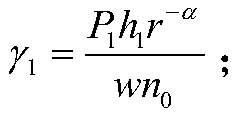A balance method of energy efficiency and spectral efficiency for ultra-dense deployment of heterogeneous networks in micro base stations
An energy-efficient and spectrum-efficient technology, applied in network planning, power management, wireless communication, etc., can solve the problem of dedicated channel deployment, which is seldom studied, cannot well meet the requirements of stable evolution of cellular systems, and interlayer interference, etc. problems, to maximize energy efficiency, ensure user service quality, and improve network capacity
- Summary
- Abstract
- Description
- Claims
- Application Information
AI Technical Summary
Problems solved by technology
Method used
Image
Examples
Embodiment
[0044] refer to figure 1 , a method for balancing energy efficiency and spectrum efficiency in a heterogeneous network with ultra-dense deployment of micro base stations, comprising the following steps:
[0045] 1) Construct the network model, divide the network bandwidth and determine the spectrum usage mode: refer to figure 2 , the network model is that in a macro cell with a radius of R, the macro base station is located at the origin, the micro base station and the mobile user obey the independent spatial Poisson point process within the coverage of the macro base station, and the density is λ m ,λ u ; The division of the network bandwidth is to divide the available network bandwidth W evenly into m sub-channels, and the bandwidth of each sub-channel is w, where m 1 subchannels are assigned to the macro base station, and the remaining m 2 =m-m 1 sub-channels are assigned to micro base stations, and all micro base stations share spectrum resources; the spectrum usage m...
PUM
 Login to View More
Login to View More Abstract
Description
Claims
Application Information
 Login to View More
Login to View More - R&D
- Intellectual Property
- Life Sciences
- Materials
- Tech Scout
- Unparalleled Data Quality
- Higher Quality Content
- 60% Fewer Hallucinations
Browse by: Latest US Patents, China's latest patents, Technical Efficacy Thesaurus, Application Domain, Technology Topic, Popular Technical Reports.
© 2025 PatSnap. All rights reserved.Legal|Privacy policy|Modern Slavery Act Transparency Statement|Sitemap|About US| Contact US: help@patsnap.com



